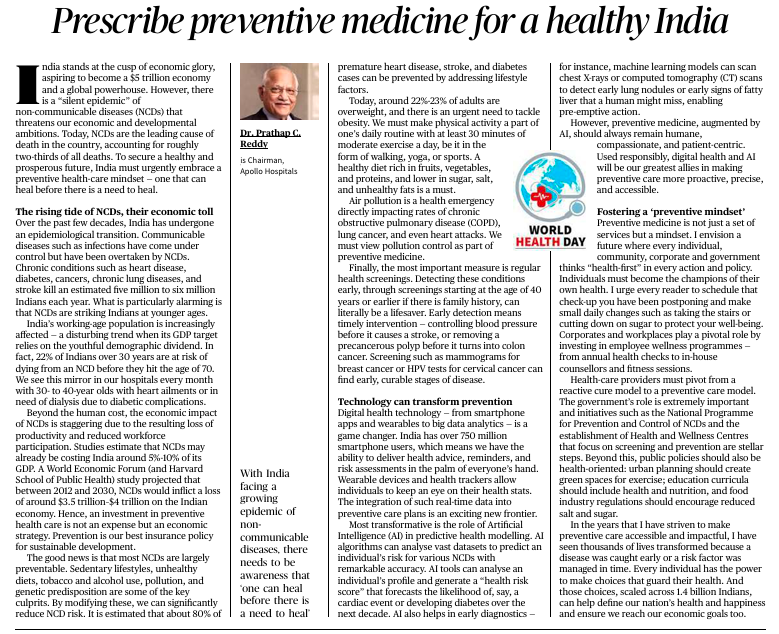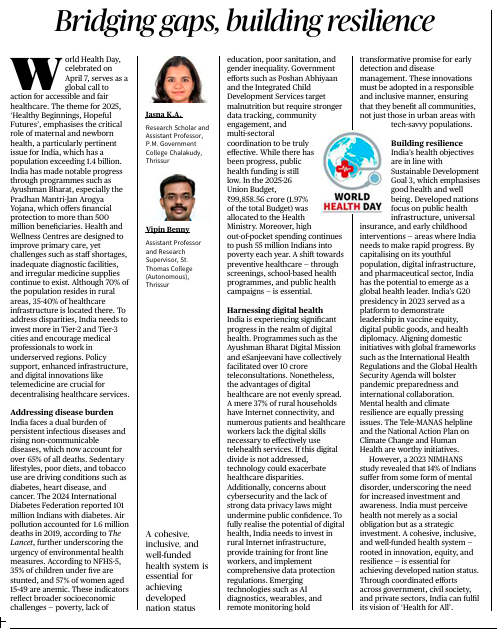Prescribe preventive medicine for a healthy India
General Studies Paper II – Governance, Health, and Policy
INTRODUCTION:
India must urgently invest in a preventive healthcare model to combat the silent epidemic of non-communicable diseases (NCDs) such as heart disease, diabetes, cancer, and stroke, which now cause two-thirds of all deaths in the country.
📉 Economic & Human Cost of NCDs
- NCDs have overtaken communicable diseases due to India’s epidemiological transition.
- Estimated 5–6 million deaths annually due to NCDs like heart disease and stroke.
- NCDs are striking younger populations, reducing economic productivity.
- 22% of Indians over 30 are at risk of dying from an NCD before age 70.
- 30- to 40-year-olds regularly visit hospitals for severe NCD-related complications.
- Economic loss from NCDs is projected at $3.5 trillion–$4.6 trillion by 2030.
⚠️ Key Risk Factors
- Obesity: Affects 22%–23% of adults; requires urgent attention.
- Sedentary lifestyle: Need for at least 30 minutes of daily physical activity.
- Diet: Shift to healthy diet — fruits, vegetables, reduced salt/sugar/fats.
- Air pollution: Causes COPD, lung cancer, and heart attacks.
- Lack of regular screening: Late detection worsens outcomes.
- Low awareness and access to early diagnosis.
🧠 Technological & Preventive Solutions
- Screening starting at age 40 (or earlier if family history exists).
- Use digital health tools, AI, and machine learning (e.g., to detect early-stage diseases via X-rays or CT scans).
- Encourage regular health checkups, vaccinations, and awareness.
- AI and digital health can make care precise, humane, and accessible.
💡 Preventive Mindset Needed
- Prevention is not just a service; it’s a mindset and culture.
- Every individual and institution should prioritize health first.
- Daily habits: Take stairs, reduce junk food, cut sugar/salt, etc.
- Workplaces should support employee health with wellness programs and counsellors.
🏥 Role of Government & Health Providers
- Shift from reactive cure to preventive care.
- Support institutions like:
- National Programme for Prevention and Control of NCDs
- Wellness Centres
- National Programme for Prevention and Control of NCDs
- Public spaces should encourage healthy living: clean air, nutritious food, physical activity.
- Health-care providers must include dietary advice, exercise counseling, and mental health support as part of treatment.
🌍 Vision for the Future
With consistent policy support and societal awareness, India can transform from a country reacting to disease into one that proactively protects and promotes health.
PRACTICE MAINS QUESTION:
“Preventive healthcare is not just a service, but a mindset.” Discuss this statement in the context of India’s growing burden of non-communicable diseases (NCDs). (250 words)
Building gaps, Building resilience
📝 General Studies Paper II – Governance, Social Justice, Health
INTRODUCTION:
World Health Day 2024 theme: “My Health, My Right”.
- Emphasis on accessible and fair healthcare for all.
- Focus: Mental and newborn health — especially critical in populous nations like India.
✅ Progress Made
- Flagship schemes like:
- Ayushman Bharat – Jan Arogya Yojana (AB-PMJAY): Free hospitalization for 500 million beneficiaries.
- Health and Wellness Centres (HWCs): Primary care, diagnostics, medicines.
- Ayushman Bharat – Jan Arogya Yojana (AB-PMJAY): Free hospitalization for 500 million beneficiaries.
- Outcome: Expanded access, especially in rural areas.
- Challenge: Still, 33–50% of rural population lacks access to critical services.
🚫 Persistent Health Inequities
- Disparities across regions: Urban–rural, rich–poor, and inter-state gaps.
- Women and children disproportionately affected:
- 57% of women aged 15–49 are anaemic.
- 32% of children under 5 are underweight.
- 57% of women aged 15–49 are anaemic.
- Contributing factors: Poverty, gender inequality, low education, malnutrition, sanitation issues.
📉 Low Public Health Spending
- India’s public health spending is only 1% of GDP (₹88,956 crore) — low by global standards.
- For comparison, high-income countries spend around 5% or more of GDP.
🧠 Need for Multi Sectoral Coordination:
- Health outcomes are tied to nutrition, sanitation, education, and gender equity.
- Government programs like Poshan Abhiyaan and ICDS help but need stronger implementation and convergence.
💡 Harnessing Digital Health Innovations
- India is progressing in digital health initiatives:
- National Digital Health Mission
- eSanjeevani Telemedicine
- National Digital Health Mission
- Digital health can help bridge gaps in remote/rural areas.
- Over 77% of rural households have smartphones—digital tools are accessible.
- Examples of digital use: AI for diagnostics, remote monitoring, health record systems.
🧱 Building Resilient Health Systems:
- Resilient healthcare system is:
- People-centred
- Cohesive and equitable
- Digitally enabled
- Well-funded and community-linked
- People-centred
- India’s G20 presidency theme emphasized “One Earth, One Health.”
🧭 Path Forward
- Integrated healthcare must be the focus.
- Expand infrastructure, improve workforce distribution, and ensure gender-sensitive policies.
- Strengthen primary healthcare and digital innovations.
- Increase public health investment and move toward universal health coverage.
✨ Conclusion
- India must move toward resilient, inclusive, and equitable healthcare.
With strong leadership, technological adoption, and community involvement, India can achieve “Health for All.”
PRACTICE MAINS QUESTION:
“India’s healthcare system must evolve from service delivery to system resilience.” Discuss this statement in the context of building equitable and accessible healthcare. (250 words)



